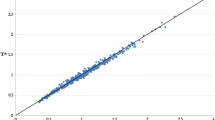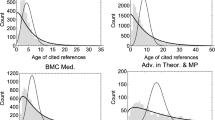Abstract
This paper studies evidence from Thomson Scientific (TS) about the citation process of 3.7 million articles published in the period 1998–2002 in 219 Web of Science (WoS) categories, or sub-fields. Reference and citation distributions have very different characteristics across sub-fields. However, when analyzed with the Characteristic Scores and Scales (CSS) technique, which is replication and scale invariant, the shape of these distributions over three broad categories of articles appears strikingly similar. Reference distributions are mildly skewed, but citation distributions with a 5-year citation window are highly skewed: the mean is 20 points above the median, while 9–10% of all articles in the upper tail account for about 44% of all citations. The aggregation of sub-fields into disciplines and fields according to several aggregation schemes preserve this feature of citation distributions. It should be noted that when we look into subsets of articles within the lower and upper tails of citation distributions the universality partially breaks down. On the other hand, for 140 of the 219 sub-fields the existence of a power law cannot be rejected. However, contrary to what is generally believed, at the sub-field level the scaling parameter is above 3.5 most of the time, and power laws are relatively small: on average, they represent 2% of all articles and account for 13.5% of all citations. The results of the aggregation into disciplines and fields reveal that power law algebra is a subtle phenomenon.

Similar content being viewed by others
Notes
Recall that references are made to many different items: articles in TS-indexed journals, as well as articles in conference volumes, books, and other documents, none of them covered by TS. Moreover, some references are to articles published in TS journals before 1998 and, hence, outside our dataset.
It is important to emphasize that these results coincide with those obtained in Albarrán and Ruiz-Castillo (2011) when analyzing reference and citation distributions using the original dataset in which each article is assigned by TS to only one of 22 broad fields.
References
Albarrán, P., Crespo, J., Ortuño, I., & Ruiz-Castillo, J. (2011). The skewness of science in 219 sub-fields and a number of aggregates. Working Paper 11-09, Universidad Carlos III.
Albarrán, P., & Ruiz-Castillo, J. (2011). References made and citations received by scientific articles. Journal of the American Society for Information Science and Technology, 62, 40–49.
Burke, P., & Butler, L. (1996). Publication types, citation rates, and evaluation. Scientometrics, 37, 473–494.
Clauset, A., Shalizi, C. R., & Newman, M. E. J. (2009). Power-law distributions in empirical data. SIAM Review, 51, 661–703.
Dorogovstev, S., & Mendes, J. (2001). Scaling properties of scale-free evolving networks: Continuous approach. Physical Review E, 85, 4633–4636.
Egghe, L. (2005). Power laws in the information production process: Lotkaian informetrics. Kidlington: Elsevier Academic Press.
Glänzel, W. (2007a). Characteristic scores and scales: A bibliometric analysis of subject characteristics based on long-term citation observation. Journal of Informetrics, 1, 92–102.
Glänzel, W. (2007b). Some new applications of the h-index. ISSI Newsletter, 3, 28–31.
Glänzel, W. (2008). On some new bibliometric applications of statistics related to the h-index. Scientometrics, 77, 187–196.
Glänzel, W. (2010). The application of characteristics scores and scales to the evaluation and ranking of scientific journals. In Proceedings of INFO 2010 (pp. 1–13). Havan, Cuba.
Glänzel, W., & Schubert, A. (2003). A new classification scheme of science fields and subfields designed for scientometric evaluation purposes. Scientometrics, 56, 357–367.
Irvine, J., & Martin, B. R. (1984). CERN: Past performance and future prospects. II. The scientific performance of the CERN accelerators. Research Policy, 13, 247–284.
Jackson, M., & Rogers, B. (2007). Meeting strangers and friends of friends: How random are social networks? American Economic Review, 97, 890–915.
Kleiber, C., & Kotz, S. (2003). Statistical size distributions in economics and actuarial sciences. Hoboken: Wiley.
Laherrère, J., & Sornette, D. (1998). Stretched exponential distributions in nature and economy: Fat tails with characteristic scales. European Physical Journal B, 2, 525–539.
Lehmann, S., Lautrup, B., & Jackson, A. D. (2003). Citation networks in high energy physics. Physical Review, E68, 026113–026118.
Lehmann, S., Lautrup, B., & Jackson, A. D. (2008). A quantitative analysis of indicators of scientific performance. Scientometrics, 76, 369–390.
Liang, L., & Rousseau, R. (2010). Reference analysis: A view in the mirror of citation analysis. Geomatics and Information Science of Wuhan University, 35, 6–9.
Magyar, G. (1973). Bibliometric analysis of a new research sub-field. Journal of Documentation, 30, 32–40.
Narayan, S. (1971). Power law relations in science bibliography—a self consistent interpretation. Journal of Documentation, 27, 83–97.
Peterson, G., Presse, S., & Dill, K. (2010). Nonuniversal power law scaling in the probability distribution of scientific citations. Proceedings of the National Academy of Sciences of the United States of America, 107, 16023–16027.
Price, D. J. D. S. (1965). Networks of scientific papers. Science, 149, 510–515.
Radicchi, F., Fortunato, S., & Castellano, C. (2008). Universality of citation distributions: Toward an objective measure of scientific impact. Proceedings of the National Academy of Sciences of the United States of America, 105, 17268–17272.
Redner, S. (1998). How popular is your paper? An empirical study of the citation distribution. European Physical Journal B, 4, 131–134.
Redner, S. (2005). Citation statistics from 110 years of physical review. Physics Today (pp. 49–54).
Schubert, A., & Glänzel, W. (2007). A systematic analysis of Hirsh-type indices for journals. Journal of Informetrics, 1, 2179–2184.
Schubert, A., Glänzel, W., & Braun, T. (1987). A new methodology for ranking scientific institutions. Scientometrics, 12, 267–292.
Schubert, A., Glänzel, W., & Braun, T. (1989). Scientometric datafiles: A comprehensive set of indicators on 2,649 journals, 96 countries in all major fields, sub-fields 1981–1985. Scientometrics, 16, 3–478.
Seglen, P. (1992). The skewness of science. Journal of the American Society for Information Science, 43, 628–638.
Tijssen, J. W., van Leeuwen, T. (2003). “Bibliometric analysis of world science”, extended technical annex to chapter 5 of the third European report on science and technology indicators. Directorate-General for Research. Luxembourg: Office for Official Publications of the European Community.
Tsallis, C., & de Alburquerque, M. P. (2000). Are citations of scientific papers a case of nonextensivity? European Physical Journal B, 13, 777–780.
Van Raan, A. F. J. (2006). Statistical properties of bibliometric indicators: Research group indicator distributions and correlations. Journal of the American Society for Information Science and Technology, 57, 408–430.
Wallace, M., Larivière, V., & Gingras, Y. (2009). Modeling a century of citation distributions. Journal of Informetrics, 3, 296–303.
Waltman, L., van Eck, N. J., & Noyons, E. (2010). A unified approach to mapping and clustering of bibliometric networks. Journal of Informetrics, 4, 629–635.
Acknowledgments
The authors acknowledge financial support from the Spanish MEC through grants SEJ2007-63098, SEJ2007-67436, ECO2009-11165, and ECO2010-19596. The database of Thomson Scientific (formerly Thomson-ISI; Institute for Scientific Information) has been acquired with funds from Santander Universities Global Division of Banco Santander. This paper is part of the SCIFI-GLOW Collaborative Project supported by the European Commission’s Seventh Research Framework Programme, CoSSH7-CT-2008-217436, and was presented in a Poster Session of the STI Conference held in Leiden, 9-11 September, 2010. References and suggestions by a referee led to an improved version of the paper.
Author information
Authors and Affiliations
Corresponding author
Rights and permissions
About this article
Cite this article
Albarrán, P., Crespo, J.A., Ortuño, I. et al. The skewness of science in 219 sub-fields and a number of aggregates. Scientometrics 88, 385–397 (2011). https://doi.org/10.1007/s11192-011-0407-9
Received:
Published:
Issue Date:
DOI: https://doi.org/10.1007/s11192-011-0407-9




